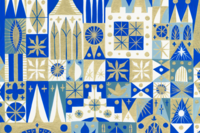This eight-week course continues to refine artist and animator skills explored in After School Animation I/Beginner. Continuing students should arrive prepared to work on their individual projects during the class and learn additional animation techniques and tips throughout the course. Students...
Animation is a versatile medium that allows animators to explore storytelling beyond traditional drawing. Paper, clay, and even sand have proven to be other unique ways to animate a tale. This eight-week course will focus on understanding basic animation principles, with each session working with a...
Dogs come in all unique shapes and sizes—it’s no wonder that these loveable creatures have been given the title of “Man’s Best Friend.” Grab your leashes and hang on tight as we take a brisk walk through the illustration of dogs in animation over the centuries. In this six-week virtual class, we...
Dogs come in all unique shapes and sizes—it’s no wonder that these loveable creatures have been given the title of “Man’s Best Friend.” Grab your leashes and hang on tight as we take a brisk walk through the illustration of dogs in animation over the centuries. In this six-week virtual class, we...
Grab your magic wands and join us as we celebrate the 70th anniversary of Disneyland Park (1955)! In this workshop, we will take a sneak peek at the development and transformation of the park over the years and delve into the folklore of fairies. From the Fairy Godmother to Tinker Bell, these...
“Can you paint with all the colors of the wind?” Meet us “just around the riverbend” as we honor the 30th anniversary of Disney’s Pocahontas (1995)! We will look behind the scenes of the film and observe how hair within the world of animation can become a lively character of its own. Then, with our...
“Can you paint with all the colors of the wind?” Meet us “just around the riverbend” as we honor the 30th anniversary of Disney’s Pocahontas (1995)! We will look behind the scenes of the film and observe how hair within the world of animation can become a lively character of its own. Then, with our...
“Can you paint with all the colors of the wind?” Meet us “just around the riverbend” as we honor the 30th anniversary of Disney’s Pocahontas (1995)! We will look behind the scenes of the film and observe how hair within the world of animation can become a lively character of its own. Then, with our...
“Can you paint with all the colors of the wind?” Meet us “just around the riverbend” as we honor the 30th anniversary of Disney’s Pocahontas (1995)! We will look behind the scenes of the film and observe how hair within the world of animation can become a lively character of its own. Then, with our...
Join us in our Art Studio where you can enjoy evening cocktails and follow along as our Education staff teaches you step-by-step instructions on how to paint a whimsical castle.
“Oh, Pluto!” This sweet pup has been a loyal companion to Mickey Mouse since 1930. Don your party hats and join us as we celebrate Pluto’s 95th anniversary! This workshop will highlight Pluto’s origins and the ways animators have used art techniques to display specific personality traits within dogs...
“Oh, Pluto!” This sweet pup has been a loyal companion to Mickey Mouse since 1930. Don your party hats and join us as we celebrate Pluto’s 95th anniversary! This workshop will highlight Pluto’s origins and the ways animators have used art techniques to display specific personality traits within dogs...
“Oh, Pluto!” This sweet pup has been a loyal companion to Mickey Mouse since 1930. Don your party hats and join us as we celebrate Pluto’s 95th anniversary! This workshop will highlight Pluto’s origins and the ways animators have used art techniques to display specific personality traits within dogs...
“Oh, Pluto!” This sweet pup has been a loyal companion to Mickey Mouse since 1930. Don your party hats and join us as we celebrate Pluto’s 95th anniversary! This workshop will highlight Pluto’s origins and the ways animators have used art techniques to display specific personality traits within dogs...
Join us in our Art Studio where you can enjoy evening cocktails and follow along as our Education staff teaches you step-by-step instructions on drawing a fun and loyal pet companion.
Follow the butterflies’ migration this Fall and their presence within the world of animation! This special workshop will take a whimsical behind-the-scenes look of how tiny (yet mighty) creatures like butterflies have fluttered in different animated pieces from Walt Disney’s Bambi (1942) to Disney’s...
Follow the butterflies’ migration this Fall and their presence within the world of animation! This special workshop will take a whimsical behind-the-scenes look of how tiny (yet mighty) creatures like butterflies have fluttered in different animated pieces from Walt Disney’s Bambi (1942) to Disney’s...
The Artist Studio is geared toward adult and children ages 7 and up. Exploring the world of animation, guests can step into our Learning Center to discover aspects of stop-motion and specific film techniques. Our Education staff will be present to support, encourage, and inspire students to grab...
Join us for an exclusive virtual Alice in Wonderland-themed “tea” party and chat with internationally acclaimed drag performer Nina West and actress Ashley Eckstein. West and Eckstein will discuss their experiences performing, acting, writing children’s books, their friendship, their mutual love of...
The Walt Disney Family Museum is delighted to announce Mary Blair: Mid-Century Magic, a special exhibition exploring the creative vision and achievements of one of Walt Disney’s most imaginative and renowned designers and art directors.










